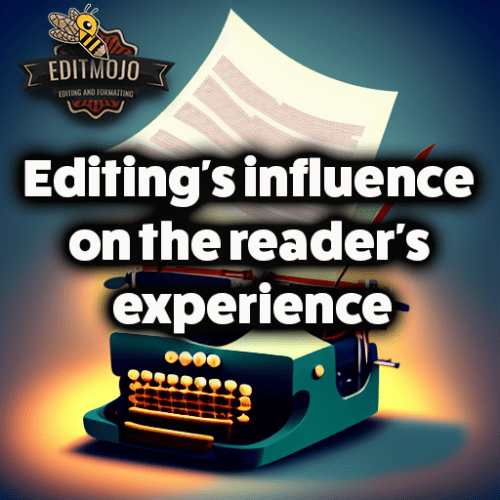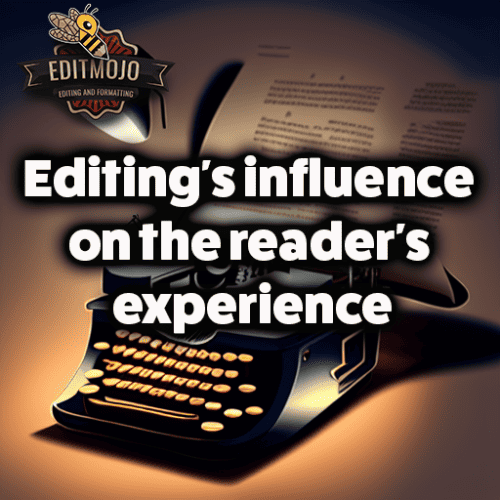Editing’s influence on the reader’s experience
Editing’s Influence on the Reader’s Experience. Imagine yourself on a wild, untamed adventure, venturing into the thrilling world of a book. You’re immersed in the characters’ lives, exploring their world, caught up in their emotions and conflicts. The words you’re reading might seem to flow effortlessly, but have you ever stopped to consider the journey they’ve taken to reach you? The hidden hero of every story is the editing process, an essential but often overlooked part of creating captivating narratives. This post will delve into how editing significantly influences the reader’s experience.
Key Takeaways (Editing’s influence on the reader’s experience)
| Section | Takeaways |
|---|---|
| Introduction | The editing process is vital in shaping a reader’s experience with written content. |
| Role of Editing | Different types of editing (substantive, line editing, copy editing, proofreading) contribute uniquely to refining a written piece. |
| Power of Editing | Editing significantly shapes the narrative, impacting the story’s perception. |
| Editing and Comprehension | Editing ensures the clarity and continuity of content, improving reader comprehension and engagement. |
| Emotional Resonance | Through strategic editing, emotional impacts can be enhanced, deepening the reader’s connection to the story. |
| Consistency and Credibility | Editing ensures consistency and credibility, building trust with the reader and enhancing their overall experience. |
| Pacing | Editing controls the pacing of the narrative, guiding the reader’s journey through the story. |
| World-Building | In genres like fantasy or science fiction, editing refines the world-building elements to enhance believability and immersion. |
| Digital Era Impact | Editing has evolved to cater to digital formats and the scanning habits of online readers, reinforcing its importance. |
| Conclusion | Editing plays a crucial role in influencing the reader’s experience by shaping the narrative, ensuring clarity, and enhancing emotional resonance among other aspects. |
II. The Vital Role of Editing in Writing
Editing is the magic that polishes a piece of writing, transforming it from a raw draft into a refined masterpiece. Its purpose is to optimize the author’s ideas for clarity, coherence, and engagement, shaping the narrative into its best form. The world of editing is vast, with various types — substantive, line editing, copy editing, and proofreading. Each of these contributes uniquely to the final product, ensuring that the writing is structured, error-free, grammatically sound, and conveys the intended message effectively.

III. The Unseen Power of Editing
Editing holds the power to shape the narrative, impacting how the story is perceived. Just as a sculptor chisels away at a block of marble to reveal a beautiful statue, an editor carves out the essence of a story from a block of text. A raw draft might contain the skeleton of a story, but it’s the editing that fleshes it out, giving it life and making it compelling for the reader. Consider the famous quote by Ernest Hemingway: “The first draft of anything is shit.” Hemingway’s words reflect the importance of editing, showing that even literary masters understand the necessity of refining their work.
IV. Editing’s Impact on Reader Comprehension and Engagement
Editing ensures that the writing flows smoothly, keeping the reader’s comprehension and engagement at the forefront. Clarity is the linchpin of reader comprehension. A well-edited piece is like a map with a clear path, making it easier for the reader to follow the narrative. Moreover, editing works to maintain the reader’s engagement, removing any obstructions that might disrupt the reading experience. Like a skilled gardener, an editor prunes away irrelevant details and confusing elements, allowing the narrative to bloom.

V. Editing and Emotional Resonance
Emotion is the heart of storytelling, creating a deep bond between the reader and the narrative. The power of editing lies in its ability to enhance this emotional impact. Imagine reading two versions of a heart-wrenching scene: one filled with run-on sentences, distracting punctuation, and overused clichés, the other revised to let the raw emotion shine through. The difference would be palpable. In the hands of a skilled editor, words can be crafted to stir the reader’s emotions in subtle and powerful ways.
VI. Editing for Consistency and Credibility
Consistency is paramount in keeping the reader engrossed. Any inconsistencies in the storyline, characters, or details can break the reader’s immersion. By ensuring consistency, editing builds the reader’s trust, making the narrative believable. Additionally, fact-checking is another essential facet of editing. It upholds the narrative’s credibility, particularly in non-fictional pieces or fiction with a basis in real-world elements. A factually accurate piece leaves a lasting impression, enhancing the reader’s experience.
VII. The Art of Pacing: How Editing Controls the Reader’s Journey
Pacing is the rhythm of the narrative — it influences how quickly or slowly the reader navig
ates through the story. Editing plays a crucial role in controlling this pacing, dictating when to speed up the action or slow down for introspective moments. It’s like the tempo in music, setting the beat for the reader’s journey. This balance is critical. A well-paced narrative can keep readers on the edge of their seat, hooked until the last word.
VIII. The Role of Editing in World-Building
World-building is particularly crucial in genres like fantasy or science fiction, where the reader is transported into unfamiliar realms. Editing shapes these worlds, refining the details to make them believable and immersive. J.K. Rowling’s Harry Potter series provides an excellent example of meticulous world-building. The magical world of Hogwarts was brought to life not just through Rowling’s vivid imagination but also through thorough editing, ensuring the consistency and credibility of the fantastical elements.
IX. The Influence of Digital Era on Editing and Reader’s Experience
In the digital age, the role of editing has taken on new dimensions. Online readers often scan content rather than read every word, requiring the text to be even more concise and engaging. Hyperlinks, SEO, and other digital considerations have become part of the editing process. Furthermore, with the rise of e-books and audiobooks, editing techniques have evolved to cater to these formats. The digital revolution has reaffirmed the importance of editing in enhancing the reader’s experience.

X. Conclusion (Editing’s influence on the reader’s experience)
While the writing process is undeniably important, it’s the editing that breathes life into a story, influencing the reader’s experience in numerous ways. Editing shapes the narrative, maintains engagement, enhances emotional resonance, ensures consistency, controls pacing, aids world-building, and keeps up with the digital era’s demands. Remember, every great story you’ve ever read has been through the diligent hands of an editor. The next time you’re lost in a book, take a moment to appreciate this invisible art.
XI. Call to Action
I invite you to share your experiences with reading edited versus unedited content. Have you ever noticed the impact of editing on your reading experience? Or perhaps you’re an aspiring editor or writer. How do these concepts resonate with your work? As we explore the invisible art of editing, let’s appreciate its influence on our reading journey and continue the conversation in the comments section below.
Top Five Questions and Answers (Editing’s influence on the reader’s experience)
| Question | Answer |
|---|---|
| What is the purpose of editing in written content? | The purpose of editing is to optimize the author’s ideas for clarity, coherence, and engagement, shaping the narrative into its best form. |
| How does editing shape the narrative of a story? | Editing shapes the narrative by refining the language, enhancing the story’s flow, and ensuring the effective conveyance of themes and messages. |
| How does editing affect reader comprehension and engagement? | Editing ensures clarity and continuity of content, making it easier for readers to follow along and stay engaged with the narrative. |
| In what ways does editing enhance emotional resonance in a story? | Editing can strategically craft and arrange words to stir the reader’s emotions, thereby enhancing the emotional impact of a story. |
| How has the digital era influenced the role of editing? | The digital era has seen the incorporation of SEO and other digital considerations in editing. It has also seen editing adapt to formats like e-books and audiobooks. |
